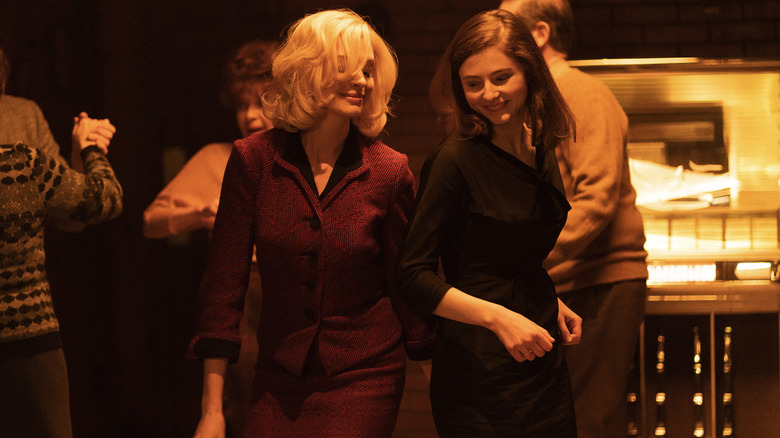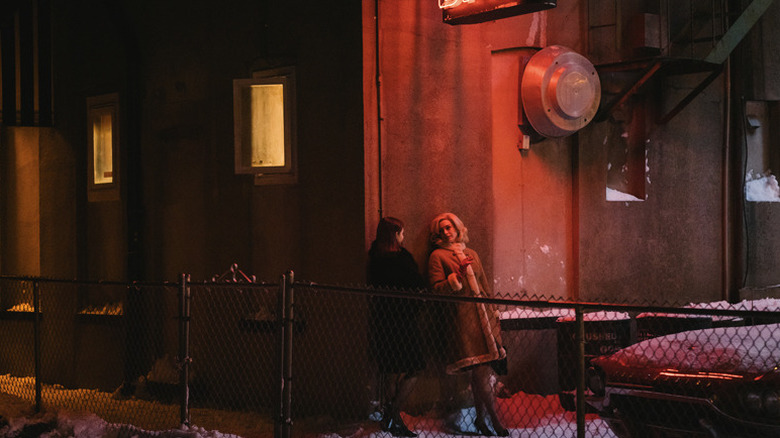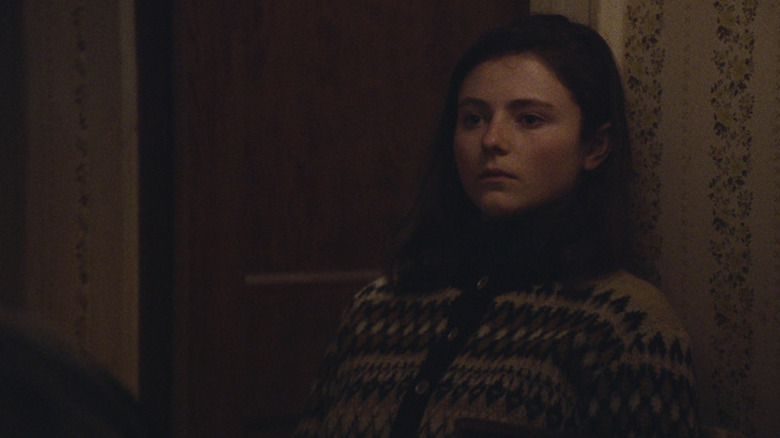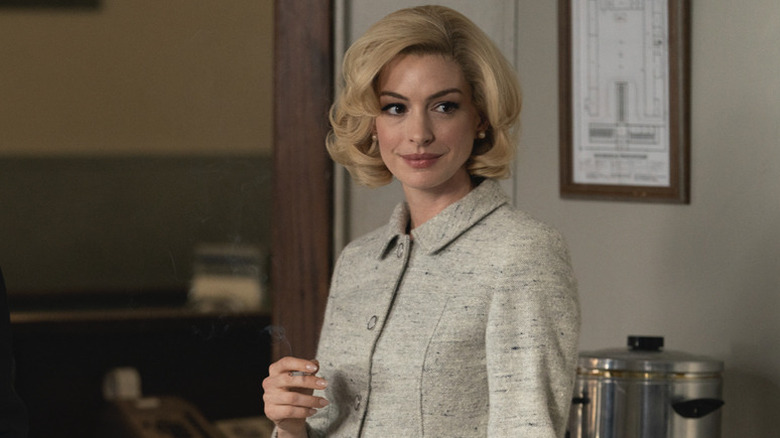Eileen Director William Oldroyd Talks About Being Proven Wrong By Anne Hathaway [Exclusive Interview]
This post contains spoilers for "Eileen." Seriously. If you haven't seen the movie yet, please check it out and then return to this article.
I fell hard for "Eileen" when I saw it at the Sundance Film Festival earlier this year, so I was thrilled to have the opportunity to speak with director William Oldroyd to mark the film's wide release. This is his second feature film, and he's now made two movies about young women who feel restricted by the worlds they live in and dramatically lash out as a result. That's certainly true of his first film, 2016's "Lady Macbeth," which helped catapult a young Florence Pugh to stardom, and for a significant portion of its runtime, it seems as if "Eileen" is going to be a much different kind of story — a lush but low-key period romance between a mousy young prison employee played by Thomasin McKenzie and a glamorous prison psychiatrist played by Anne Hathaway. But things take quite a turn near the end of the film, and discussing that pivot point is how my conversation with Oldroyd begins.
We spoke about his approach to that revelatory kitchen scene, collaborating with cinematographer Ari Wegner ("The Power of the Dog," "Zola," "The Wonder"), the toughest part of making this movie, and that time Anne Hathaway totally proved him wrong on set (in a nice way).
Note: This interview has been lightly edited for clarity and brevity.
'I was so shocked by it'
I just want to jump in and talk about the end of the movie with you. I've never read this book, so I was floored when the reveal happens in the kitchen. That is easily one of my favorite movie moments of the year so far. The entire tone of the film really shifts at that point, so I imagine it must've been pretty important to you to get that right. So I was curious if you could tell me about how you approached that scene.
Well, what I wanted to try and achieve was what I had felt when I read the book, which was, I read it more or less in one sitting, and when I got to the point you mentioned, the turning point, the twist, I was so shocked by it. I thought, "Well, if we could achieve that on screen, it would be great, but how do we do that?" And ultimately, the answer was we just trusted what [author and co-screenwriter] Ottessa [Moshfegh] had written, which was Rebecca has to say where they are and what's going on, when typically you would want to show that. The reveal would be revealed to Eileen, because we're her point of view, by Rebecca, visually. And yet actually, I think what we discussed — Ottessa, Luke [Goebel], and I — when writing the script, what I discussed with Ari Wegner, the cinematographer, and also then with Annie and Thomasin, was if Rebecca was to say that, we'd have a greater shock for Eileen.
Because Eileen is there thinking it's a date. So when she realizes why she's actually there, what we need to see is we need to see her register the shock of that information, and also see her heartbreak that she's not there for a Christmas date, for drinking and dancing and whatever else. Then from that point on, Ottessa would say the same, from that point on, it just hurtled towards the end in a way that it completely provides Eileen with the sort of stimulus that she needs in order to get out of her life in X-ville and move on. [Editor's note: Eileen's Massachusetts town is referred to as "X-ville" in the novel, but not in the movie.]
You mentioned Ari Wegner, and I know that you two have collaborated before. What kind of conversations did you have with her early on about what you wanted this movie to look like and feel like?
Ari's great because, before you have any sort of aesthetic conversation, she wants to get right under the skin of the character. She really wants to dig deep into the script itself and understand its structure, how we came to write it. And we went straight back to the book. So there was quite a few weeks where we spent time just talking about the book and the script. And then once we understand the psychology of the character, that helps us to understand how to motivate camera, how to move camera. It's not a superficial decision in terms of aspect ratio, whether we're going to use zoom lenses from the '60s, whether we're going to use digital or film. It comes out of a conversation of, "Well, we're in Eileen's point of view and what do we want to try and achieve?"
And like with "Lady Macbeth," we have a singular perspective. We want to really get into the mind of Eileen. We want to reference some of the films from that period, from 1963, without falling into the trap of pastiche. And that led us to the look that we found. She was very interested in trying to light each scene with the lights that were available at the time. So these sodium street lamps, for example, were a big element of the look. I mean, a lot of the interior scenes are lit from outside the house, for example, from a streetlight that came through. It's a very sort of sickly yellow strange light. And then obviously working with Olga Mill, the costume designer, to make sure that the palette then also works with the lights that they've chosen. And also Craig Lathrop, the set designer. But essentially, it all worked in tandem, because we also had the contrast of this sort of blue-gray, New England coastal environment. So we had those two working together.
'I think if a director can build trust between themselves and an actor, I think you can really ask actors to do anything'
When I watched the movie, I could practically feel the icy cold weather emanating off of the screen, and I was curious if it actually was cold when you all filmed this or if you had to use a lot of movie magic to achieve that feeling.
It was zero movie magic. I mean, ask the actors: There was no acting required. I mean, it was New Jersey, December, January. It was brutal. [laughs] Not brutal for someone who lives there, but for me, coming from a slightly warmer country, it was like whoa. Yeah. It was actually quite a difficult thing. And poor Thomasin, she was not really — she was wearing some woolen layers, but really the clothes of the '60s were not ... we're all in our high-tech gear, standing behind the camera. She's wearing tights and a woolen skirt and a blouse, putting snow in her underpants. [laughs]
So lately I've been fascinated by the idea that a big part of a director's job is managing personalities. And for this movie, I was wondering if Anne and Thomasin needed different things as actors. Did you have to balance their particular quirks or preferred methods as actors in order to create an environment where they could give these great performances?
Yes, and that is established early on. So, for example, one of the first things I like to do when I meet an actor, usually almost even when we have the sort of first meeting when we're talking about a project, is understand how they like to work. Because I'm not the sort of person who's going to dictate some sort of working methodology. I'm interested to know how an actor likes to work. I mean, sometimes they will not really tell the truth. They'll say, "Well, however you like to work." But actually, I know that's not the truth. Everybody has a particular way they like to work, and actually it's just about asking enough questions to draw it out of them.
Then it's about finding a way of getting two people to work together who may not have a similar approach. We were lucky with this project because we shot in two blocks over Christmas. The first was in December, then we had a two-week break for Christmas, then we shot the second block. The first block was Eileen and her dad, so Thomasin and Shea [Whigham], and then we had Eileen and Rebecca in the second block. So I'd already built a relationship with Thomasin in the sense that I understood how she liked to work. So that was very helpful.
And then I'd spoken to Annie a lot about how she likes to work, and I was lucky in the sense that both of them come fully prepared. They're so professional. They know their lines — obviously, I mean, that goes without saying — but they also have a very strong idea of what they want to do. So when we arrive on set, a decision has been made, and then it's a case of seeing how that idea works and then trying out a few different alternatives. But we have already established a lot of the thoughts of each scene in the rehearsal we had before. So we had a couple of days for Thomasin and Annie to meet each other before we started to shoot, and that was about understanding who they are as characters, what the thoughts are, and make sure they're clear in the script.
And it's really about building trust. I think if a director can build trust between themselves and an actor, I think you can really ask actors to do anything.
'She was right'
You mentioned that they had ideas that they wanted to bring to these characters, and Anne, especially, is unreal in this movie. What did she bring to this role that surprised you, if anything?
What I thought was interesting is that she knows, because she has such extraordinary screen experience, she knows the level at which, and she knows where, to pitch it. Which is remarkable, because watching it in the room may not necessarily be what transmits on the screen. So actually, when I watched the dailies, I could then see that she had pitched it absolutely right. That, for me, was astonishing. You're surrounded by so many unhelpful influences in the moment of shooting the scene, because you're there with the whole crew and there's so much going on, and you're already thinking about the next scene, and you've got it in your head, and you've got to hold everything together. You try and focus as best you can on performance, but you're also thinking of a million other things that are happening in the frame. But Annie really knew where she pitched it, and she was right, and that gave me great confidence. I could totally trust her to know where to [pitch it].
Did you learn that after just a few days of being able to look at the dailies? Because that seems like such a surreal thing for a director, to be as dialed in as you are on the set and have an actor give a performance, and a tiny alarm bell or something goes off in your head where you're like, "I'm not really sure if that's right." But then when you check the tape, it actually is right. That's got to be destabilizing in a small way, right?
Well, but it's also, you've got to find humility as well, because if an alarm bell rings, then you've got to get the take that you feel is right for yourself. So you do the versions up to that point. That version, then the ones in between, and then you stop at the point where you go, "I think we've got it." And then when you watch it back, then you think, "She was right. She was right. [laughs] She was right." And then I was able to go to her and say, "You're absolutely spot on." I think that relationship of mutual respect actually is very good for a working relationship, because then Annie is like, "See, I told you." [laughs] But in the kindest way possible.
Because, as you say, she is a larger than life character. We have such an extraordinary twist in this movie. It would be very easy for this to suddenly become a little arch, a different kind of movie, if we lean into that. And I had the same conversations with Shea. There is a version of alcoholic, Boston ex-cop, shouty dad, which we really wanted to steer clear of because we've seen it a million times before. And I just trust him to be able to find that. He's the one telling me, "Yeah, I think we want to be in this space. We want to be exploring this," and we'd let him then explore it because — and I'm grateful for them. These are intelligent actors who want to dig deep, and they're not going to settle for ... there would be guys who'd be like, "Oh, you want me to come for eight days?" They'll come in for eight days, just shoot this stuff, "we know how it goes, see you later." But they really wanted to find something truthful and original.
Can you tell me what the toughest part of the process of making this movie was for you?
I mean, there's so many. I mean, we shot through Covid. I mean, I'm sure you've heard a lot of people say the same thing, but it does have an impact. Everybody coming in early to test twice a day, having to wear a mask between. So an actor can't see my face when I'm trying to explain an idea to them, so a lot of the body language is lost. Having to be super vigilant, having to have doors open. The whole thing was ... it was an extra pressure when we were already shooting in minus, I don't know what it is in Fahrenheit, but in the UK, it was like minus 10 degrees. [Editor's note: That's 14 degrees F.]
Also the problem is we shot everything on location, and if you're in a small location and the camera doesn't fit in the room with the actors, you have to open the doors to shoot through a door. Well, then it's like shooting outdoors, but the actors are pretending they're indoors in a nice, cozy kitchen. I mean, that has an impact on the body. You don't want them to be thinking about, "I'm freezing." You want them to be thinking about the scene.
It was also the first time I've worked in the States, so I relied heavily on the crew and the producers to help me through that. Which wasn't actually so problematic, it was just about understanding a new system. It took a little bit of time. At the time, I would say everything was problematic, just because it was such a pressured environment. [laughs] We had 26 days to shoot this movie in so many different locations. Because with "Lady Macbeth," of course, I'd had the same amount of time, but I'd had one location and four actors. This was a much bigger scale and I was learning on the job.
Thankfully, there'd been enough time between the two movies for Ari Wegner and Nick Emerson, my two closest collaborators, the cinematographer and the editor, to have gone away and made like 10 movies in that time. So they could come back with all of that rich experience and bring it to this film, which was very, very ... it was vital, really.
"Eileen" is in theaters now.



